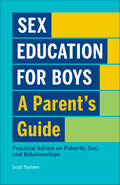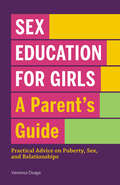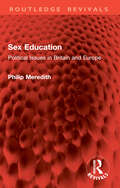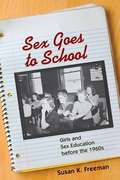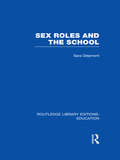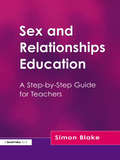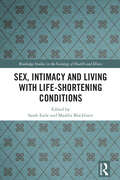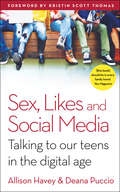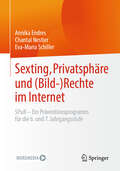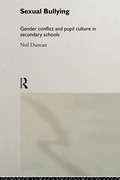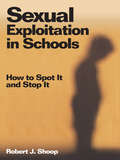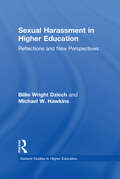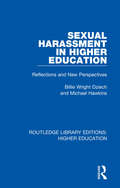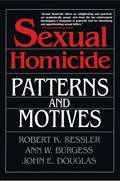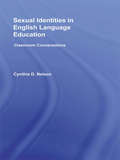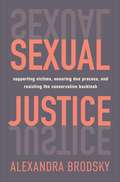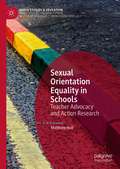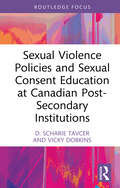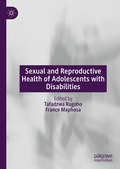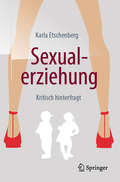- Table View
- List View
Sex Education for Boys: Practical Advice on Puberty, Sex, and Relationships
by Scott TodnemDiscover sex-positive guidance for teaching your tween or teen son what he needs to know As your son enters puberty, he's going to have a lot of questions that he'll need your help to answer. Filled with understanding and uplifting guidance, this book helps you recognize what your son is experiencing and have open conversations about everything from sexuality and gender identity to consent and safer sex.This standout among puberty books for boys features:Sex-positive talks—Tackle vital questions with direct guidance that helps you encourage your son to form a healthy attitude toward sex and sexual health.Advice for key conversations—Learn how to open lines of communication with your son on subjects like dating, social media, pornography, and toxic masculinity.Frequently asked questions—Discover answers to some of the most common questions parents have when teaching their sons about sex and sexual health.Make sure you're both ready for The Talk with Sex Education for Boys: A Parent's Guide. l
Sex Education for Girls: Practical Advice on Puberty, Sex, and Relationships
by Vanessa OsageDiscover sex-positive guidance for teaching your tween or teen daughter what she needs to know As your daughter enters puberty, she's going to have a lot of questions that she'll need your help to answer. Filled with understanding and uplifting guidance, this book helps you recognize what your daughter is experiencing and have open conversations about everything from gender identity and sexuality to consent and safer sex. What sets this book on sex education for kids apart: A sex-positive approach—Get direct guidance for tackling questions in ways that encourage your daughter to form a healthy attitude toward sex and sexual health. Advice for key conversations—Learn how to open lines of communication with your daughter on subjects like periods, dating, social media, and body image. Frequently asked questions—Discover answers to some of the most common questions parents have when teaching their daughters about sex and sexual health. Make sure you're both ready for The Talk with Sex Education for Girls: A Parent's Guide.
Sex Education: Political Issues in Britain and Europe (Routledge Revivals)
by Philip MeredithIn the book Sex Education (first published in 1989), Philip Meredith focuses upon the British situation to investigate the political management of school sex education. The author presents new insights into the problems of state provision of an aspect of education which many feel should be the exclusive domain of parents. He explores the hidden political dynamics which dictate and influence the moral debate over the theory and practice of sex education and argues for a more rational involvement of government in resolving the problems of practice.The book includes comparative details of political management and curriculum design, drawn mainly from Sweden, Denmark, the Federal Republic of Germany, Poland, and Belgium, which clarifies or provides alternatives to the British handling of the subject. Basing his recommendations on these examples of more constructive management of sex education, Philip Meredith challenges the government to take a more positive role by delegating policy decision-making in this area to a nationally representative, independent, and authoritative body of experts, whose deliberations the government would defend against minority moral interests who wield a disproportionate power.
Sex Goes to School: Girls and Sex Education before the 1960s
by Susan K. FreemanWhen seeking approaches for sex education, few look to the past for guidance. But Susan K. Freeman's investigation of the classrooms of the 1940s and 1950s offers numerous insights into the potential for sex education to address adolescent challenges, particularly for girls. From rural Toms River, New Jersey, to urban San Diego and many places in between, the use of discussion-based classes fostered an environment that focused less on strictly biological matters of human reproduction and more on the social dimensions of the gendered and sexual worlds that the students inhabited. Although the classes reinforced normative heterosexual gender roles that could prove repressive, the discussion-based approach also emphasized a potentially liberating sense of personal choice and responsibility in young women's relationship decisions. In addition to the biological and psychological underpinnings of normative sexuality, teachers presented girls' sex lives and gendered behavior as critical to the success of American families and, by extension, the entire way of life of American democracy. The approaches of teachers and students were sometimes predictable and other times surprising, yet almost wholly without controversy in the two decades before the so-called Sexual Revolution of the 1960s. Sex Goes to School illuminates the tensions between and among adults and youth attempting to make sense of sex in a society that was then, as much as today, both sex-phobic and sex-saturated.
Sex Roles and the School (Routledge Library Editions: Education)
by Sara DelamontSchools reflect the society which surrounds them but they must also be agents of change. The last few decades have seen an explosion of research on gender and education and, in this volume the author examines in a rigorous but highly accessible way, new research findings and new strategies for change, continuing to argue that both sexes lose out from sexist schooling.
Sex and Relationships Education: A Step-by-Step Guide for Teachers (Spotlight Ser.)
by Simon BlakeThis book will enable and assist teachers responsible for organizing and delivering Sex and Relationships Education. It draws together the best available practice to support teachers in developing policy and classroom practice. It begins by looking at general principles and then focuses on primary, secondary and special schools as well as pupil referral units. These chapters will provide a toolkit of ideas and approaches that teachers can use in the classroom. Included are practical exercises that can be done alone or in staff meetings to prepare yourself or a colleague to deliver SRE, a glossary of terms that will support you in answering children's and young people's questions, advice on choosing, developing and using resources, and a list of useful organizations and websites. The book will be particularly helpful to PSHE coordinators, Health Promotion Units, National Healthy School Standard coordinators and SRE teachers in schools. LEA Advisors and Inspectors, and anyone involved in training and supporting teachers, will also find this a useful guide.
Sex and the Bible
by Gerald LarueA book describing many sexual topics as they relate to the bible and Christianity
Sex, Intimacy and Living with Life-Shortening Conditions
by Sarah Earle Maddie BlackburnThis multi-disciplinary and inclusive collection brings together theoretically informed and empirically focused research on sex, intimacy and reproduction in relation to young people and adults with life-shortening conditions. Advances in healthcare mean that increasing numbers of young people with life-shortening conditions are transitioning into adulthood. Issues such as sex and intimacy, dating and relationships, fertility and having children are increasingly relevant to them and to the people that support them, including families, carers, practitioners and professional education, health and social care agencies. This three-part book explores the relevance and significance of this field, examines everyday experiences, and highlights the challenges faced by individuals and organisations in addressing the needs of such people in daily life and in the context of practice. Drawing on perspectives from sociology, disability studies, epidemiology, health policy, psychotherapy, legal studies, queer studies and nursing, this ground-breaking volume is written by academics, policy makers, practitioners and experts by experience. It is an essential read for all those practising and researching in the fields of sexuality, chronic illness and disability and transition.
Sex, Likes and Social Media: Talking to our teens in the digital age
by Deana Puccio Allison HaveyWelcome to the world of the Digital Native, where self-esteem is measured in Likes, everyone is sexting and ‘Pimps and Hoes’ is an acceptable party theme. Dates have been replaced with swipes, rape jokes are hilarious and ‘No’ means ‘Yes’. For most parents, the digital landscape that our kids and teens are growing up in is uncharted territory. How do we know if they’re happy? How do we talk to them about sex and relationships? How do we give them the new tools they need when we don’t have them ourselves?This book is here to help. Based on their professional work with young people, parents and teachers – and their experiences with their own children – Deana Puccio and Allison Havey give you the tools.With top tips, stats and conversation starters on everything from porn to University life, Sex, Likes and Social Media is the indispensible guide to parenting in the digital age.1 of the 5 Best Parenting Books - the Sun1 of the 10 Best Parenting Books - the Independent
Sexismus und Homophobie im Sport: Interdisziplinäre Perspektiven auf ein vernachlässigtes Forschungsfeld
by Martin K.W. SchweerDas vorliegende Buch bündelt aktuelle Diskurse und Ergebnisse zu den noch immer weit verbreiteten Phänomenen des Sexismus und der Homophobie im Sport. Ausgehend von einem zusammenführenden Überblick über den Status Quo der Forschung werden aus interdisziplinärer Perspektive ausgewählte inhaltliche Schwerpunkte und Handlungsfelder thematisiert, wie etwa sexistische und homophobe Tendenzen im Vereinssport, Spezifika der Fußballfanszene sowie die Analyse medialer Darstellungen und Inszenierungen zum Themenschwerpunkt ebenso wie die Analyse des Sportunterrichts mit seinem pädagogischen Potenzial. Auf diese Weise gelingt ein facettenreicher Einblick in ein Forschungsfeld, das bislang - nicht nur - im deutschsprachigen Raum zu wenig Beachtung gefunden hat.Der Inhalt• Grundlegende Überlegungen zu einem vernachlässigten Forschungsgegenstand• Ausgewählte Anwendungs- und ForschungsfelderDie ZielgruppenWissenschaftlerinnen und Wissenschaftler aus den diversen sozialwissenschaftlichen Disziplinen, Akteurinnen und Akteure im (organisierten) Sport und in pädagogisch-psychologischen HandlungsfeldernDer HerausgeberProf. Dr. Martin K. W. Schweer ist Universitätsprofessor für Pädagogische Psychologie und zugleich wissenschaftlicher Leiter der sportpsychologischen Arbeitsstelle „Challenges“ an der Universität Vechta.
Sexting, Privatsphäre und (Bild-) Rechte im Internet: SPuR - Ein Präventionsprogramm für die 6. und 7. Jahrgangsstufe
by Eva-Maria Schiller Annika Endres Chantal NestlerDieses Fachbuch enthält ein schulklassenbasiertes Durchführungsmanual für Lehrkräfte, Schulsozialarbeiter:innen, Schulpsycholog:innen und weitere an Schulen tätige Trainingskräfte. Das Ziel des SPuR-Präventionsprogramms ist es, frühzeitig einen kompetenten Umgang mit Bildmaterial im Netz zu fördern und der missbräuchlichen Verbreitung von freizügigen Fotos vorzubeugen. Zielgruppe des Programms sind Schüler:innen der 6. und 7. Jahrgangsstufe. In fünf Modulen beschäftigen sich die Schüler:innen mit den Themen Privatsphäre im Internet und dem Austausch von freizügigen Fotos über soziale Medien (sog. Sexting). Was möchte man von sich selbst preisgeben? Welche Gefahren gibt es? Wie kann man sich schützen? Und was kann man tun, wenn ein freizügiges Foto öffentlich geworden ist?Das von Schulpsychologinnen entwickelte, wissenschaftlich fundierte und erprobte SPuR-Präventionsprogramm wird im Buch ausführlich und praktisch erläutert, so dass Sie das medienpädagogische Programm selbstständig an Ihrer Schule durchführen können. Das Buch enthält zudem Hinweise für die Elternarbeit und ergänzende Online-Materialien.
Sexual Bullying: Gender Conflict and Pupil Culture in Secondary Schools
by Neil DuncanBullying is one of the most destructive but common social practices that young people experience in schools, and one of the most difficult for teachers to manage successfully. Sexual bullying is even more difficult to deal with. Most adults can recall the important part sexual reputation played in the hierarchies of peer-group popularity during secondary schooling. The significance of this formative period of our sexual identities seems obvious, but is largely ignored by education policy makers and rarely appears in staff training programmes.This book draws together a number of theories on gender, adolescent behaviour and schooling to examine social interactions in four comprehensive schools. The original research underpinning this book comprises of group and individual interviews with the pupils, case-studies and classroom-practitioner observations over a seven-year period.This book will stimulate interest amongst all concerned with pupil welfare and social change.
Sexual Citizens: A Landmark Study Of Sex, Power, And Assault On Campus
by Jennifer S. Hirsch Shamus Khan“Profoundly eye-opening.… Hirsch and Khan present a novel model for explaining and responding to campus sexual assault.” —Claire M. Renzetti, Science Research has shown that by the time they graduate, as many as one in three women and almost one in six men will have been sexually assaulted. But why is sexual assault such a common feature of college life, and what can be done to prevent it? Drawing on the Sexual Health Initiative to Foster Transformation (SHIFT) at Columbia University, the most comprehensive study to date of sexual assault on a campus, Jennifer S. Hirsch and Shamus Khan present an entirely new framework that emphasizes sexual assault’s social roots, based on the powerful concepts of “sexual projects,” “sexual citizenship,” and “sexual geographies.” Empathic, insightful, and far-ranging, Sexual Citizens transforms our understanding of sexual assault and offers a roadmap for how to address it.
Sexual Exploitation in Schools: How to Spot It and Stop It
by Dr Robert J. ShoopShoop identifies the early warning signs of sexual abuse in schools, demonstrating the critical need to implement strategies so students are protected while also learning how to protect themselves.
Sexual Harassment and Higher Education: Reflections and New Perspectives (RoutledgeFalmer Studies in Higher Education #8)
by Billie Wright Dziech Michael W. HawkinsFirst Published in 1998. Routledge is an imprint of Taylor & Francis, an informa company.
Sexual Harassment in Higher Education: Reflections and New Perspectives (Routledge Library Editions: Higher Education #8)
by Michael W. Hawkins Billie Wright DziechOriginally published in 1998, Sexual Harassment in Higher Education addresses the problem of sexual harassment on college campuses. This work reflects on a variety of aspects of sexual harassment, its litigation and law, as well as how the issues they demonstrate often have as much to do with linguistics or jurisprudence as with negative action, though there is a great deal of evidence of the latter. The book provides a clear-eyed and detailed assessment of the 'harassment' controversies now plaguing America's universities and colleges.
Sexual Homicide: Patterns and Motives
by John E. Douglas Robert K. Ressler Ann W. BurgessWho are the men committing the rising number of serial homicides in the U.S. -- and why do they kill? The increase in these violent crimes over the past decade has created an urgent need for more and better information about these men: their crime scene patterns, violent acts, and above all, their motivations for committing these shocking and repetitive murders.This authoritative book represents the data, findings, and implications of a long-term F.B.I.-sponsored study of serial sex killers. Specially trained F.B.I. agents examined thirty-six convicted, incarcerated sexual murderers to build a valuable new bank of information which reveals the world of the serial sexual killer in both quantitative and qualitative detail. Data was obtained from official psychiatric and criminal records, court transcripts, and prison reports, as well as from extensive interviews with the offenders themselves.Featured in this book is detailed information on the F.B.I.'s recently developed Violent Criminal Apprehension Program (VICAP) and a sample of an actual VICAP Crime Analysis Report Form.
Sexual Identities in English Language Education: Classroom Conversations
by Cynthia NelsonWhat pedagogic challenges and opportunities arise as gay, lesbian, and queer themes and perspectives become an increasingly visible part of English language classes within a variety of language learning contexts and levels? What sorts of teaching practices are needed in order to productively explore the sociosexual aspects of language, identity, culture, and communication? How can English language teachers promote language learning through the development of teaching approaches that do not presume an exclusively heterosexual world? Drawing on the experiences of over 100 language teachers and learners, and using a wide range of research and theory, especially queer education research, this innovative, cutting-edge book skillfully interweaves classroom voices and theoretical analysis to provide informed guidance and a practical framework of macrostrategies English language teachers (of any sexual identification) can use to engage with lesbian/gay themes in the classroom. In so doing, it illuminates broader questions about how to address social diversity, social inequity, and social inquiry in a classroom context.
Sexual Justice: Supporting Victims, Ensuring Due Process, and Resisting the Conservative Backlash
by Alexandra BrodskyA pathbreaking work for the next stage of the #MeToo movement, showing how we can address sexual harms with fairness to both victims and the accused, and exposing the sexism that shapes today's contentious debates about due processOver the past few years, a remarkable number of sexual harassment victims have come forward with their stories, demanding consequences for their assailants and broad societal change. Each prominent allegation, however, has also set off a wave of questions – some posed in good faith, some distinctly not – about the rights of the accused. The national conversation has grown polarized, inflamed by a public narrative that wrongly presents feminism and fair process as warring interests.Sexual Justice is an intervention, pointing the way to common ground. Drawing on core principles of civil rights law, and the personal experiences of victims and the accused, Alexandra Brodsky details how schools, workplaces, and other institutions can – indeed, must – address sexual harms in ways fair to all. She shows why these allegations cannot be left to police and prosecutors alone, and outlines the key principles of fair proceedings outside the courts. Brodsky explains how contemporary debates continue the long, sexist history of “rape exceptionalism,” in which sexual allegations are treated as uniquely suspect. And she calls on readers to resist the anti-feminist backlash that hijacks the rhetoric of due process to protect male impunity.Vivid and eye-opening, at once intellectually rigorous and profoundly empathetic, Sexual Justice clears up common misunderstandings about sexual harassment, traces the forgotten histories that underlie our current predicament, and illuminates the way to a more just world.
Sexual Orientation Equality in Schools: Teacher Advocacy and Action Research (Queer Studies and Education)
by Matthew HoltThis book explores how to help teachers become better advocates for sexual orientation equality in secondary schools. Examining this issue through the lens of qualitative emancipatory action research, a group of Australian teachers embarked on a journey of teacher advocacy. Critical theory has long highlighted teachers as key players in either challenging dominant social narratives, or else perpetuating oppressive systems of power through traditional forms of education. Despite this important role, the life stories of teachers, which contributed to the development of their beliefs and behaviours about sexual orientation are rarely considered in the development of anti-discriminatory policy, designing the curriculum and most importantly, in teacher training. This book suggests and frames a model for advocacy, whereby teachers engage with their personal beliefs about sexual orientation, with their role as a teacher, and commit to advocacy through action by promoting student safety, challenging heteronormative narratives and role modelling compassionate behaviours in their school environments.
Sexual Trauma among Girls in Educational Settings: Intersectional Identities and Trauma-Informed Care (Routledge Research in Education)
by Jennifer Etesse HerringThis book uses an intersectional lens to explore the lived experiences of sexually traumatized girls in school. It provides a deep understanding of the students’ experiences, viewed through the prism of their multiple identities. The author employs a qualitative phenomenological study to investigate the psychological, social, and academic impacts of such trauma.The book’s core strength lies in its exploration of the intersectionality between identity and sexual trauma. It does this by examining the impacts of historical trauma, through the lens of four major historical events: transatlantic slavery, the Holocaust, World War II, and the COVID-19 pandemic. This research highlights potential mental health, social, and academic outcomes prevalent in historically marginalized groups, which is then connected to a broader understanding of intersectionality and trauma. It underscores the urgent need for educators and school leaders to understand this phenomenon in order to be effective in their roles. The book also emphasizes the importance of addressing trauma in educational settings, considering the intersectionality of identity, trauma, and educational experience. The book also proposes an additional identity marker to support Crenshaw’s theory of intersectionality: female sexual trauma survivor. This book is a valuable resource for scholars, educators, educational leaders, post-graduate students, and policymakers. It offers research-based theoretical approaches to addressing trauma and intersectionality in educational contexts. It is a must-read for those seeking to broaden their understanding of these complex issues and their impact on educational experiences for female sexual trauma survivors.
Sexual Violence Policies and Sexual Consent Education at Canadian Post-Secondary Institutions
by D. Scharie Tavcer Vicky DobkinsThis book is the culmination of three years of research into sexual violence policies and sexual consent education at post-secondary institutions across Canada. The prevalence of sexual violence has not changed in more than 30 years, and its reporting to police or school authorities has only waxed and waned over those years. In response, this book asks what can be done differently to reduce the number of victims and potential perpetrators? The book provides an environmental scan of over 120 post-secondary institutions (PSIs) across Canada as well as a deeper analysis of 7 PSIs that also include student and staff experiences and opinions. The three-year research project employed various phases to capture over 160 student voices and over 20 sexual violence staff and subject experts. Subject experts and students were also involved in reviewing the draft iterations of the proposed sexual consent education module. This book delivers readers with a broad-brush approach to understanding the landscape of sexual violence prevention and education services at PSIs across Canada. It provides a narrowed focus on 7 PSIs where student and staff survey responses and interviews provide positionality in response to the available literature. The book concludes with a proposed sexual consent education module, including its strengths and limitations, as a point of discussion for PSIs to include into their sexual violence prevention education repertoire. This book is intended for post-secondary audiences in Canada, North America, and elsewhere – for undergraduate and graduate students and faculty, staff, and administrators – where it is crucial to consider ways to address its prevalence and the ways we can incorporate prevention education into our campus communities.
Sexual and Reproductive Health of Adolescents with Disabilities
by Tafadzwa Rugoho France MaphosaThis book investigates various experiences of teaching sexual and reproductive health to adolescents with disabilities. Following the adoption of the UNCRPD, adolescents with disabilities still commonly suffer from widespread violation of their rights particularly concerning sexual and reproductive health – often being viewed as either asexual or hypersexual. Contemporary societies do not readily encourage the participation of these young people in conversations or decision making processes concerning their own sexual and reproductive health. This book delves into such complex issues, critically examining how global communities attempt to teach sexual and reproductive issues to adolescents with disabilities in the modern era.
Sexualaufklärung und Herausforderung Pornographie
by Harri Wettstein Jakob PastötterDas Buch bietet auf der Grundlage einer wissenschaftlichen Studie Orientierungswissen zum Phänomen des digitalen Konsums von Pornos bis hin zur Sexsucht im Jugendlichenalter. Das Werk stellt das Thema kontrastierend, manchmal auch provozierend in den Kontext eines natürlichen Verständnisses von Sexualität. Es geht um Primärprävention im Sinne von psychischen Schutzmaßnahmen, die einen aufgeklärten Umgang mit dem Thema ermöglichen. Damit hilft das Werk, die Sprach- und Hilflosigkeit staatlicher Institutionen zu überwinden. Aufgrund der besonderen Expertise des Autors werden dabei auch Fragen der Fruchtbarkeit ausgehend vom Frauenzyklus behandelt. Ein einführender wie auch ein ergänzender Beitrag von Jakob Pastötter ordnen die Ergebnisse in den Forschungskontext ein. Ein dauerhaft aktuelles Thema, ein anregendes Buch, das Eltern, Psychologen, Ärzte und Pädagogen informiert - und der gesellschaftspolitischen Diskussion förderlich sein dürfte.
Sexualerziehung: Kritisch hinterfragt
by Karla EtschenbergSexualfreundliche Sexualerziehung soll und muss sein, aber wem nützt eine pro-aktiv sexualisierende Sexualerziehung und warum löst sie Widerstand aus? Ist die aktuell diskutierte Sexualpädagogik mit ihren Zielen und Methoden kindgerecht oder bedient sie Interessen von Erwachsenen? Diese Streitschrift bietet Interessierten und an Erziehung Beteiligten Informationen und Analysen, sowie persönliche Einschätzungen der Autorin, die nachdenklich machen. Das Buch reflektiert alternative Herangehensweisen an das Thema Sexualität in Kita und Schule und erklärt, warum sich religiös begründete und „moderne“ sexual-pädagogische Konzepte ähneln. Die Autorin nimmt die Leser mit in die Fragestellung und Besorgnis, ob die derzeit propagierte Sexualerziehung darauf hinausläuft, Kinder mit pädagogischer Legitimation in die sexualisierte Erwachsenenwelt hineinzuziehen. Es öffnet die Augen für die Thematik und gibt Hinweise wie Kinder und Jugendliche motiviert werden können, sich vor dem Einfluss von Pornografie zu schützen.
